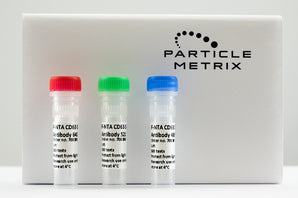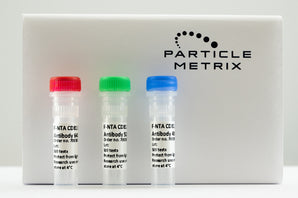Authors
Tal Gilboa, Ph.D.*, Dr. Christina Klasen**, Dr. Lena Ball**
A collaboration of
Introduction
Everest Biolabs and Particle Matrix have partnered to establish a unified workflow for extracellular vesicle (EV) analysis, combining high-purity size exclusion chromatography (SEC) isolation using Apex SEC columns with precise quantification via advanced nanoparticle tracking analysis (NTA).
One of the major challenges in EV research is that the majority of particles in plasma and serum are not EVs but rather lipoproteins and protein aggregates that overlap in size with vesicles. These contaminants can dominate total particle counts, obscure true EV signals, and lead to inaccurate conclusions about EV abundance or biomarker levels. Achieving high-purity EV isolation is therefore essential for quantitative and reproducible downstream analyses.
Apex SEC Columns: Optimizing Purity and Yield
Everest’s Apex SEC columns (4B, 6B, and MM) enable scalable EV isolation across diverse biofluids. Each column composition provides a distinct balance between yield and purity, allowing researchers to select the optimal configuration for their downstream applications. The Apex MM column, in particular, features a multi-mode resin layer that combines SEC with additional interaction mechanisms to more effectively remove lipoproteins and plasma proteins, providing higher EV purity than conventional SEC columns. These design improvements result in cleaner fractions ideal for untargeted analysis such as proteomics.
Particle Matrix NTA: Labeled and Unlabeled Particle Tracking
The Particle Metrix ZetaView® Evolution platform enables parallel measurement of unlabeled (total) and fluorescently labeled particle populations. Using membrane dyes, the fraction of membrane-enclosed particles within a sample can be determined. In combination with the Particle Metrix F-NTA Tetraspanin Detection Kits, which allow simultaneous labeling of the EV markers CD9, CD63, and CD81, the proportion of true EVs within the total particle population can be quantified. These labelling approaches enable both purity assessment (percentage of membranous particles or EVs) and precise determination of the EV concentration (EVs/mL).
Apex SEC Columns: Optimizing Purity and Yield
Everest’s Apex SEC columns (4B, 6B, and MM) enable scalable EV isolation across diverse biofluids. Each column composition provides a distinct balance between yield and purity, allowing researchers to select the optimal configuration for their downstream applications. The Apex MM column, in particular, features a multi-mode resin layer that combines SEC with additional interaction mechanisms to more effectively remove lipoproteins and plasma proteins, providing higher EV purity than conventional SEC columns. These design improvements result in cleaner fractions ideal for untargeted analysis such as proteomics.
Combining SEC with NTA analysis:
When EV fractions are analyzed using both total particle counts (unlabeled NTA) and EV-specific measurements (F-NTA or ELISA), the ratio between total and labeled particles serves as a sensitive indicator of purity (figure 1). As isolation purity improves, this ratio approaches 100%, reflecting the removal of non-EV particles and enrichment of genuine vesicles. Furthermore, a strong correlation is observed between F-NTA results and Atlas EV ELISA measurements, supporting the consistency and accuracy of the combined analytical approach.

Figure 1: Figure 1: Comparison of EV purity across SEC columns. A) Total particle concentration (NTA scatter, gray) and membrane dye–positive particle counts (red) obtained for each Apex column type.
(B) EV-specific Atlas ELISA signal expressed as a percentage of total particle scatter.
(C) Fraction of membrane dye–positive particles relative to total scatter (% membrane dye/scatter), indicating the proportion of lipid-bound vesicles. The Apex MM column achieved the highest EV purity, whereas the Apex 6B column provided greater total particle recovery but lower marker-specific enrichment.
Antibody labelling of samples with low purity, like plasma EVs can be challenging due to the trade-off between achieving sufficient labeling and avoiding background from excess unbound antibodies—often requiring extensive dilution that compromises accuracy. As illustrated in Figure 2, performing the labeling step prior to SEC fractionation offers an effective strategy to overcome these challenges. By applying a higher antibody concentration during staining, labeling efficiency is significantly improved. The subsequent SEC step removes unbound antibodies, preventing background fluorescence despite the increased antibody density. This enhanced labeling efficiency is reflected by a higher number of tracked fluorescent particles, leading to improved statistical robustness and more reliable quantitative results. As a result, this workflow enables brighter, faster, and more accurate EV detection.
 Figure 2: Fluorescent nanoparticle tracking analysis (F-NTA) before and after SEC. A) Experimental workflow: EVs were labeled either before or after size-exclusion chromatography (SEC) using Apex 6B columns, then analyzed by fluorescent NTA (F-NTA) with the ZetaView Evolution system. B) Total particle count signals (scatter) and fluorescent particle count signals (F-NTA) measured before and after SEC demonstrate that labeling the plasma prior to SEC increases the number of detectable fluorescent particles. This results in improved statistical robustness, reflected by reduced error bars, while the overall measurement outcome remains consistent between pre- and post-SEC labeling (C). D) Fraction-resolved analysis of scatter (gray, left axis) and F-NTA (green, right axis) showing correlation between the two measurements with the expected EV elution profile in Apex columns.
Figure 2: Fluorescent nanoparticle tracking analysis (F-NTA) before and after SEC. A) Experimental workflow: EVs were labeled either before or after size-exclusion chromatography (SEC) using Apex 6B columns, then analyzed by fluorescent NTA (F-NTA) with the ZetaView Evolution system. B) Total particle count signals (scatter) and fluorescent particle count signals (F-NTA) measured before and after SEC demonstrate that labeling the plasma prior to SEC increases the number of detectable fluorescent particles. This results in improved statistical robustness, reflected by reduced error bars, while the overall measurement outcome remains consistent between pre- and post-SEC labeling (C). D) Fraction-resolved analysis of scatter (gray, left axis) and F-NTA (green, right axis) showing correlation between the two measurements with the expected EV elution profile in Apex columns.
Combined Workflow: EV-Specific Insights
Together, Apex SEC columns and the ZetaView® Evolution deliver complementary insights into EV biology. SEC efficiently separates EVs from contaminating particles, while the ZetaView® quantifies both total and EV-specific populations. The convergence of total and labeled particle counts after SEC highlights the purity of the isolation process, and pre-labeling EVs before SEC enhances sensitivity in fluorescence NTA measurements.
This integrated workflow establishes a robust framework for high-precision EV characterization - linking isolation purity with quantitative and particle-specific analysis.
Methods
Plasma fractionation using Apex SEC columns:
Apex SEC columns were pre-equilibrated with 17 mL of 1× PBS. Subsequently, 0.5 mL of pooled plasma was loaded onto the column, followed by the addition of 2 mL of PBS as discard volume. Thereafter, 0.5 mL fractions were collected. The SEC run was performed using the automated Ascent instrument.
Antibody staining of plasma EVs
For the labeling of plasma-derived extracellular vesicles (EVs) prior to SEC fractionation, 2 ml of plasma were incubated for one hour with 10 µl of each antibody (CD9, CD63, and CD81) from the Particle Metrix F-NTA EV Tetraspanin Detection Kit. Subsequent SEC fractionation was carried out according to the manufacturer’s recommendations using Everest Biolabs Apex SEC columns. The first three fractions were collected and used for EV analysis with the ZetaView® Evolution.
Labeling of plasma EVs after SEC fractionation was performed in accordance with the protocol provided in the F-NTA EV Tetraspanin Detection Kit.
Membrane staining of plasma EVs
For the labeling of membrane-enclosed particles, 1 µl of fraction 2 from the Apex SEC columns was incubated for one hour with 1 µl of CellMask™ Deep Red (Thermo Fisher Scientific), diluted 1:2000 in PBS.
NTA and F-NTA Analysis
Measurements were performed on the ZetaView® Evolution quatt instrument using the ZetaSphere Software. The measurement settings of the PMX EV PAN Staining method were applied for all analyses.
*Everest Biolabs
**Particle Metrix GmbH
Contact address Everest Biolabs:
Everest Biolabs, 204 Second Ave, Suite 102, Waltham, MA 02451, USA
Disclaimer: While we have taken every care to ensure that the information in this document is correct, nothing herein should be construed as implying any representation or warranty as to its accuracy, correctness or completeness of this information and we shall not be held liable for any errors therein or for any damages in connection with the use of this material. Particle Metrix reserves the right to change the content of this material at any time without notice.
Copyright: © November 2025 Particle Metrix. This publication or parts thereof may not be copied or distributed without our express written permission.





